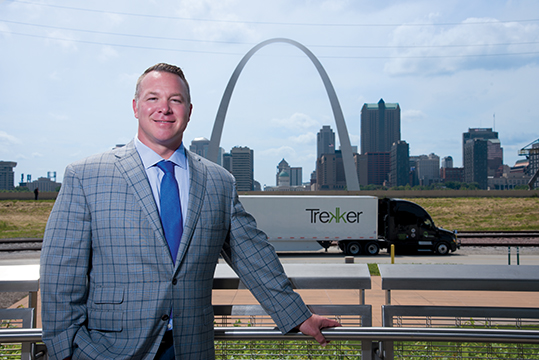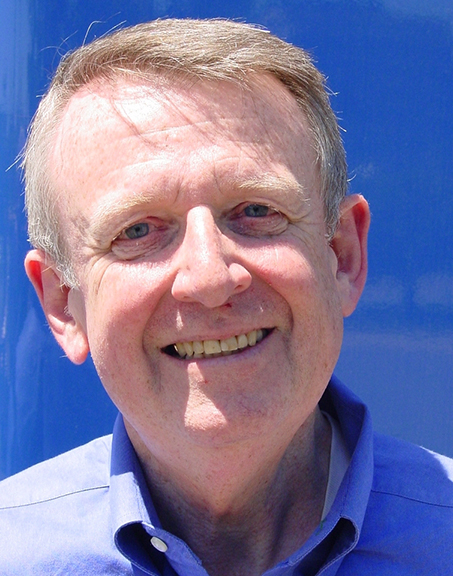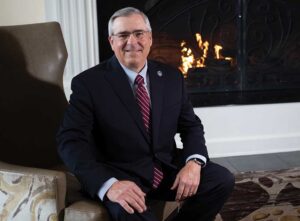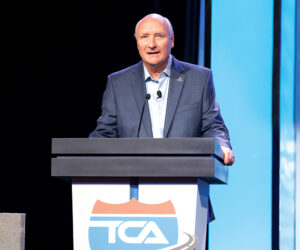Last March during the Truckload Carriers Association’s 2019 Annual Convention in Las Vegas, TCA Chairman Josh Kaburick said in his address that the Association would continue to grow, strengthen, and thrive. “There is no end in sight for our upward trajectory,” he said. And that’s exactly what has happened. In his final chat, Chairman Kaburick talks about the accomplishments of the past year, regulatory issues in progress, the unending need for an infrastructure plan and more importantly a way to pay for it, and the impact of the now two-year-old electronic logging mandate. He concludes with a word of commendation for incoming TCA Chairman Dennis Dellinger.
Mr. Chairman, thank you for joining us for the last of your “Chat with the Chairman” interviews. It’s hard to believe this is the last one. The year has gone by quickly. What have been TCA’s major accomplishments during the past year?
Wow, if only we could start with an easier question. Major accomplishments this year are many, but let’s start with these. Our education platforms continue to achieve higher marks than ever. We are providing our members with information-gathering opportunities and they are embracing them. Webinars and certification programs are exceeding expectations and continue to demonstrate that they are delivering what the members want. Our growing membership numbers, at an unprecedented rate, show that the secret is out on us. People are noticing the value that we deliver and are looking to be part of an entity that will improve their businesses. The office remodel was long overdue – new paint, floors, and HVAC have provided staff and visiting members with a first-class environment, reflective of what we are looking to provide to all who visit. Business relationships and information distribution, as well as industry image improvements, are all conducted at TCA headquarters, and I hope every member takes the opportunity to participate in them. The doors are always open; please go visit.
What achievement makes you the most proud?
It is tough to limit achievements to just one, but what makes me the most proud is the loudness of our voice. We are telling our story, and not just staff either, but our members have embraced the opportunity to walk on Capitol Hill, educate on truckload issues, and discuss matters that are important to the industry and their fleets. It has become a sight to behold. Our Call on Washington is expected to reach 100 people this year, a tremendous achievement, considering just three years ago only 35 people attended. Our Fall Business Meetings have reached that level of being a “must-attend” event. It is where decisions are made and discussions ensue for this important association, and our members are embracing that. It is not often you see an institution gain a voice, but I can say that I have had a front-row seat to watch it happen, and I could not be prouder.
What has been your biggest frustration?
As membership grows by leaps and bounds, it is hard to define this as a frustration, but remember, I am a football player, too. If you aren’t moving forward then you are moving backward. I want more people to recognize what TCA is delivering, more people to be involved and more people to wear our shield. I know our numbers already are excellent, and I can’t stress that enough, but I want to blow the roof off of these numbers and demonstrate that TCA is the association to belong to.
In addition to your chairmanship, what has been your view of the association during the time you spent as an officer?
Wow, time flies. Throughout my tenure as an officer I have witnessed tremendous membership growth. The numbers speak for themselves, but our growth has not just been in raw numbers; it has also been demonstrated by activity. Any trade association cannot succeed without true membership commitment and involvement. I remember stepping into the officer’s group in 2013 and, while it has been seven years, the view of the association is dramatically different from what it once was. Our programs have been updated, debate and discussion over important industry-related topics is not shunned but rather encouraged, and quite frankly, the expectations have grown. We have come to expect the very best from our staff, our members, and anything else we are involved in, and those expectation have led to tremendous success. This makes me look forward to what the next seven years have to offer.
The Insurance Institute on Highway Safety says it is opposed to portions of the hours-of-service rule, particularly the ability to extend the 14-hour clock, which IIHS says would create more fatigue among drivers. Can you please speak to that concern?
Quite obviously IIHS is entitled to its opinion, but it is important that we view the potential HOS changes in a holistic 24-hour period rather than the uncertainty of a longer workday. Our drivers’ day has been dramatically scrutinized over the past few years because they are now operating in an environment in which electronic logging device (ELD) data has demonstrated that detention is taking its toll on our industry. Many view the current 11/14-hour window as plenty of time to perform daily duties; however, the aforementioned data has shown that our drivers are not getting anywhere close to those numbers. As an industry, our drivers average roughly 6.5 hours of drive time per day, so even if the day becomes longer in their eyes, we may only begin to approach our 11-hour limit. The real issue is that it should be viewed as an opportunity for increased flexibility, giving drivers the option to rest when they see fit and stop that on-duty clock to obtain a break which they require and deserve. This is a choice that most drivers feel they do not presently have as they battle congestion, weather, and detention time.
Speaking about the Drug and Alcohol Clearinghouse, most of the teeth of the rule has been in place for a few weeks when this chat is published. What are the major benefits of this rule?
Everyone has heard, even touted, our industry’s zero-tolerance policy when it comes to drugs and alcohol. The benefits of having the Clearinghouse in place provide carriers with even more information concerning the drug-testing history of potential and current drivers. This allows the industry to see potential red flags with prospective drivers seeking employment in their fleet. We do, however, still wait for the opportunity to include results from hair testing as well, as many carriers have demonstrated greater success rates with this test than the basic urine tests. Once hair testing can be incorporated into the federal protocols, the Clearinghouse will be an even greater tool for vetting drivers.
The ELD mandate will have been in place for just over two years when your chairmanship is over. In addition to improving hours-of-service compliance, how has the trucking industry benefited in terms of new types of data collected, and are you aware of any negative consequences as a result of the mandate?
If you listen to Dave Heller, in addition to HOS compliance, data has certainly become one of the main benefits of what the ELD has to offer. Industry is being informed of issues that were once anecdotal but are now ringing true with the data that ELDs are providing us. Is detention a problem? Of course, and now the data is proving this and showing us where it has become a problem. HOS data has shown parking problems, speeding issues, and even congestion points, all issues, that provide carriers greater opportunity to tell their story. You are right though; with the benefits that the data is providing, there is also some risk. Data-privacy concerns are growing, and with that knowledge, I do encourage every carrier to know exactly who owns their data and what they are doing with it. There are privacy considerations that coincide with producing that much data, and the burden certainly is on the carriers to decipher the challenges that come with this important compliance tool.
The lack of parking has been an ongoing issue in the trucking industry for as long as anyone can remember. When asked, many drivers will tell you that strict enforcement of the ELD mandate has compounded the problem. Two questions: do you agree with drivers, and what are the top two solutions to alleviating the parking problem?
Our drivers represent the front line of our industry, and anyone who may not listen to what drivers are saying should probably begin to start. Yes, parking trucks has always been a problem, and as I alluded in the previous question, the ELD is showing that. Is there a remedy, even two as your question suggests? Of course. Flexibility in the sleeper berth is one solution, providing drivers with some additional options for driving and allowing them to stop the 14-hour clock. Additional parking spots and dedicating dollars to do just that is another option. There is a bill right now floating around that provides dollars for this exact issue. I will take it a step further and say that even a new infrastructure plan would help ease some of the parking pressure. Any plan that will provide extra dollars to improve our national network of roads and bridges can help alleviate some congestion in the highly traveled freight lanes. This, in turn, could change parking points for drivers who may seek to get off the road at popular truck stops.
Another ongoing issue in trucking is driver turnover. The turnover rate at large truckload fleets – those with more than $30 million in annual revenue – jumped nine points in the third quarter, the largest quarterly increase since the second quarter of 2016, to an annualized rate of 96%. The increase set the figure at its highest point since the second quarter of 2018. Much of the turnover involves drivers jumping from one carrier to another. What can carriers do to better retain their current driver force?
This is one of those “Midas touch” type of questions in which I certainly wish I had the answer that would cure our industry’s retention problem. Honestly, this is one of those things that fleets must discover what works for them, as no two fleets are the same. If you are in a rut when it comes to retention, think outside the box. If your numbers are creeping up and the “old” ways just aren’t working anymore, try something new. Open discussions are great; driver involvement is even better. Find a corporate solution that you can stand behind and the results could be dramatic.
This question falls into the category of “here we go again,” or as Yogi Berra would say, “it’s de ja view all over again.” Early in his presidency, President Donald Trump promised a comprehensive infrastructure plan to address the nation’s need to repair existing roads and bridges and build new ones, but nothing has happened. In recent weeks, both Republicans and Democrats have come forth with competing infrastructure plans. Why is it important for Congress to pass a bipartisan infrastructure plan, and can that be accomplished in the partisan culture of today’s Washington?
In today’s Congress, bipartisan could be considered a four-letter word, but when it comes to infrastructure, it represents the best case in which we really need to get something done. Unfortunately, this was a campaign issue in 2016 and is one again here in 2020 because nothing is getting done. Sound roads and bridges are needed in this nation — there is no argument on that front — but Congress must surely begin having the hard conversations about how to pay for it, with the knowledge that any plan must have buy-in from both parties. Today’s divided Congress can sideline a bill with the snap of its fingers based on party lines, but the reality is that they have to come together and get this done, for the betterment of our industry and this nation as a whole.
Passing an infrastructure plan is only the beginning. Funding is the next step. A majority of the trucking industry agrees that increasing the fuel tax is the best funding mechanism. Even though in last year’s general election, over 90% of state transportation funding initiatives were approved by voters, Congress seems reluctant to do the same at the federal level. Tolls and vehicle miles traveled (VMT) taxes are being talked about more and more. Please speak to the funding issue.
This is the hard conversation to have, and you’re right, states are certainly having positive results at their level. Yet federally speaking, there seems to be a logjam on what really makes sense. Tolls are a non-starter; it just doesn’t make sense to pay that much money in administrative costs. VMT tax is a growing idea, but our nation is just not there yet, as many, including TCA’s Highway Policy Committee, have discussed the concerns that coincide with this funding mechanism. Let’s put it this way: If you are donating to charity, doesn’t it make sense choose the one where your dollar goes the furthest? Of course it does, and with infrastructure funding, a fuel-tax increase is the best choice. The return on investment is low, as the administrative fees are only about 1%, and the mechanism to pay at the pump is a no-brainer. Our industry is willing to do its part by paying more at the pump and index any increase to inflation so that the Highway Trust Fund is always solvent. I get it; we still must find ways to account for the mileage that electric vehicles travel on the roads. A mile is still a mile, and the wear and tear that they could eventually create will present a burden, so we must find a way to account for those vehicles. The reality is, we must embrace a fuel tax increase, index it to inflation, and become part of the solution to fix for our crumbling infrastructure, not grow the problem.
The 82nd TCA Annual Convention will be held in March. What are you looking forward to most about the convention, and why is it important for members to attend?
I am not sure you have enough pages for me to tell you about what I am looking forward to the most. Honestly, I enjoy getting to see old friends and making new ones. Our educational sessions are once again top notch and will deliver the content of what we as an industry are looking for. The Truckload Strong event is again very electrifying and presents an opportunity to grow the efforts of our association, its important programs like Highway Angel, and better sustain our government affairs efforts. And I have not even mentioned baseball’s Iron Man,
Cal Ripken Jr. The meeting has come to represent an opportunity for our members to show up, speak up, and get involved in truckload. This is our industry, and our members need to be involved.
A lot of members don’t realize the sacrifices chairmen and officers make in their time spent away from their families and businesses in order to fulfill their duties. Would you comment on that?
Sacrifice is an interesting word to describe this commitment. I get it. Time away from your personal and family life is not always ideal, but I will ask everyone reading this: Where else can you find a place where you can surround yourself with like-minded people, working toward the same goal in an effort to make the industry better? This is a commitment, no doubt about that, but also one that is incredibly rewarding. I have made friends that will last a lifetime for both myself and my family, created a sounding board for success, and am involved in an association whose sole focus is to represent the industry that I work in. If that is a sacrifice, then sign me up.
As is tradition, we always ask the outgoing chairman to give advice to the incoming chairman. What would be your advice to Dennis Dellinger?
My advice to Dennis: Enjoy the moment because time will fly, and while it may only be a calendar year, that time goes by much quicker than you realize. Enjoy the members and staff – each one possesses the same dedication that we do. Finally, encourage everyone to participate, show up, speak up, and get involved. Our association will be in a much better place when that happens.
Thank you, Mr. Chairman, for a wonderful year. Any closing comments to the membership would be welcomed.
I just want to thank everyone for their support, not just this year and not just for me, but for the association as a whole. It has been a fantastic year, and I know the future is looking even better.
Lyndon Finney’s publishing career spans over 55 years beginning with a reporter position with the Southwest Times Record in Fort Smith, Arkansas, in 1965. Since then he’s been a newspaper editor at the Southwest Times Record, served five years as assistant managing editor of the Arkansas Democrat-Gazette in Little Rock and from November 2004 through December 2019 served as editor of The Trucker. Between newspaper jobs he spent 14 years as director of communications at Baptist Health, Arkansas’ largest healthcare system. In addition to his publishing career he served for 46 years as organist at Little Rock’s largest Baptist church.








